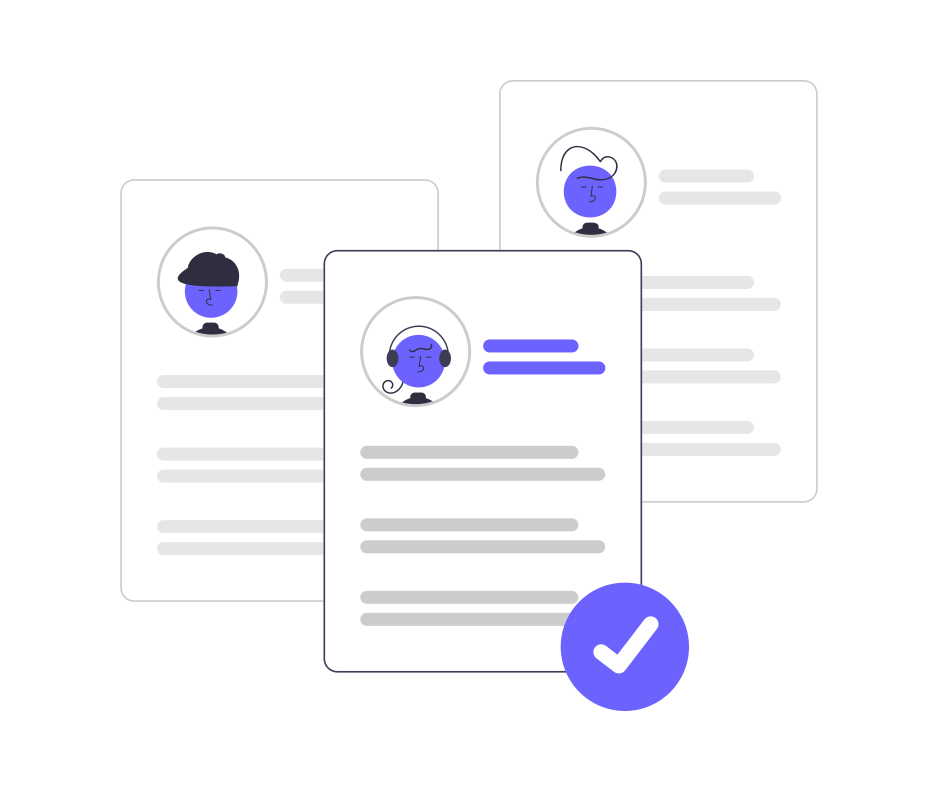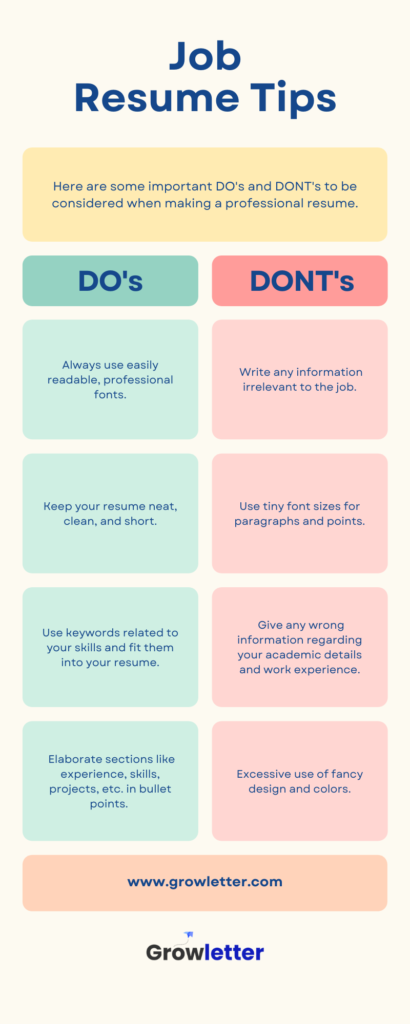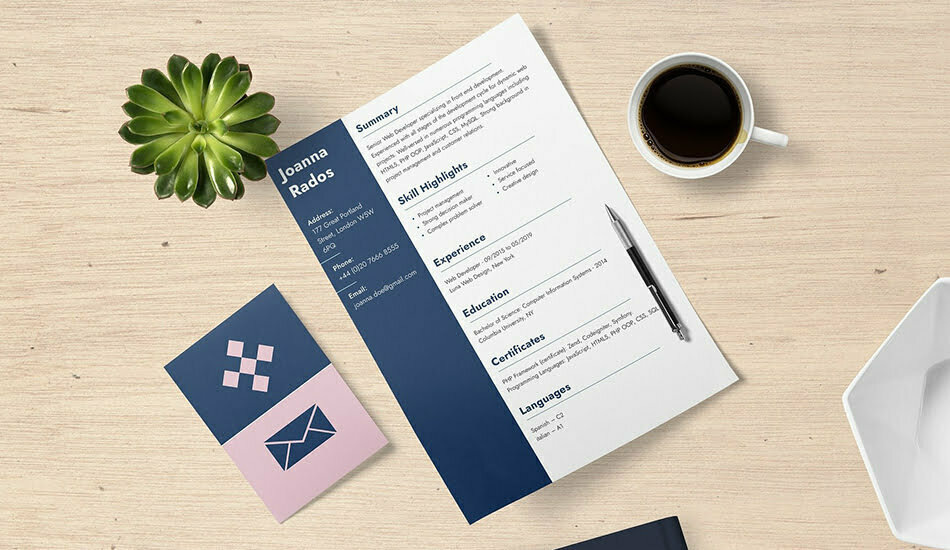“What is a job resume?” is the first question that springs immediately to mind. A job resume is a document that demonstrates your skills, academic and professional background, personality, and areas of interest to a recruiter. On the other hand, preparing a job resume that attracts recruiters can often become tricky. So, in this article, we will discuss various tips and steps for writing a professional resume that showcases your skills and potential in front of the company you want to work for.


Resume format, font style, and size
It is best to use a simple, neat, and clean template for your resume. For that, you can use Docs or Microsoft free templates. Alternatively, you can select a blank page from MS Word and start editing your resume.
Let’s talk about the font and size you should use. Even though there is no specific rule for that, you should use a font style that is easy to read, such as Roboto, Open Sans, Calibri, Times New Roman, etc. Additionally, keep the font style the same throughout your resume to maintain consistency. To make things readable, use a font size of at least 10–12 px, depending on the font style.
The contents you must have in your job resume
Due to the high level of competition, recruiters are only able to spend a few minutes on a resume. Thus, to grab their attention, you should include only the relevant information and make your resume as concise as possible. Following that, we will go through each of the sections that you should include in your job resume one by one.
Heading
In the header section, you have to fill in the following things:
- To begin with, write your name. Make it in bold font.
- Next, write down your contact information, including your email address and phone number.
- Mention any social media profiles you have, such as LinkedIn or Twitter.
Short Professional Summary
In the professional summary section, you need to introduce yourself in two to five sentences, including the following points:
- Mention your expertise in a specific field.
- Your most job-oriented skills
- A synopsis of your prior work experience and the value you can bring to the company or organization if hired.
Professional Experience
This section allows experienced candidates to demonstrate how their experience is suitable for the position that they are seeking.
- Mention your past work experience in detail, including the company name, job title, position, location, and time of employment.
- If you worked for the same company in multiple roles, create a separate section for each one.
- Under each job title, list your job responsibilities in bullet points.
- When you write about your experience, quantify your previous contributions. For example, if you are a sales executive, you could mention your accomplishments as “Managed to increase a sale from 15% to 20% in a month.” Similarly, try to quantify your other accomplishments whenever applicable. This shows the effect of your previous efforts on the company.
Note: Keep in mind that your work experience details match your job description.
If you are a fresher, you might be asking yourself, “What should I put in my experience section?” Since you are a fresher, you do not have a lot to include in your experience section. You could, however, include the following on your resume:
- If you have done some projects in college, mention your best projects with the project name and the duration taken for the project.
- Mention if you have done any internships.
- You can list any part-time job you have in addition to your academics on your resume.
For freshers, the experience section will come after the academic details. Working professionals, on the other hand, can write their experience details first, followed by the education section.
Educational Qualifications and Certifications
In this section,
- Write your academic details in reverse chronological order. That means your most recent qualification will appear first, followed by the least recent one.
- If you have any certifications relevant to the job application, you can mention them.
- For freshers, the name of the institute/college, course, grade point average, or percentage, along with the year of graduation, should appear in reverse chronological order.
- If you are pursuing any degree, you can mention the expected completion year.
Skills and Awards
You can add the following things to this section:
- Mention any skills that are relevant to your job description. For example, JavaScript and ReactJS are two commonly required skills for a Front-End web developer job profile.
- Furthermore, add a few soft skills like strong communication, problem-solving, teamwork, adaptability, etc.
- Also, include any honors or awards you’ve received.
- Write down all the languages in which you are proficient.
Do’s and Dont’s for your job resume


Note: To increase your chances of being shortlisted, include keywords throughout your resume. To make a list of keywords, go to any job portal, for example, Naukri, Indeed, etc., type in your job, and check different job postings. Try to find the most common required skills from each posting and mix them with your skills in your job resume.
Application Tracking Systems (ATS)
Nowadays, the majority of companies use ATS systems to scan and filter resumes by scanning keywords. It enables recruiters to quickly shortlist candidates that might be a good fit for the job profile. Hence, you should tailor your resume to the job’s required skills and keywords.
Important considerations to bear in mind before making your resume ATS-friendly,
- Make sure your resume has a suitable heading. For example, a summary, work experience, education, skills, etc.
- Check your resume for errors or spelling mistakes. You can avoid errors by proofreading your data using online tools.
- Choose your keyword wisely on your resume. Make sure you thoroughly read the job description and skill details before adding them to your resume. For example, an SEO executive job posting requires job-related skills like strong analytical skills, excellent writing skills, and knowledge of SEO tools like Google Analytics, Google Search Console, etc. You now have the keywords; add them strategically under your skills or work experience section. Keep in mind that you should not use this keyword repeatedly in your resume.
- Choose a simple layout for your resume. For headlines, use a larger font, and for the rest of your writing, use a smaller font.
- You should use both short and long acronyms on your resume. For instance, if you have an MBA, write “Masters of Business Administration (MBA).”
Your resume is now ready to be submitted to job portals. You need to make sure your resume contains information such as your name, address, achievements, and so on. If you believe changes are required, make them as soon as possible. Always remember not to provide any false information about yourself.
Conclusion
Through this article, I hope you have gained an understanding of the basic layout of a job resume, what the various sections are, and how to fill each of them. I attempted to simplify every important point so that you could easily prepare your resume for your next job.

